Potential and Covert Crisis: A Detailed Report on Crisis Management
VerifiedAdded on 2023/04/19
|9
|1944
|374
Report
AI Summary
This report provides an overview of crisis management, emphasizing the significance of corporate responsibility, media relations, and reputation management during critical situations. It delves into the nature of potential crises, which require proactive managerial actions to prevent escalation, and covert crises, where early identification and effective response are crucial. The report highlights the importance of corporate identity, image, and reputation in maintaining stakeholder confidence. It also underscores the need for strategic corporate responsibility initiatives and positive media relations to mitigate the impact of crises and ensure organizational stability. The document concludes with recommendations for enhancing a company's ability to navigate crises effectively, including proactive reputation management and stakeholder engagement.
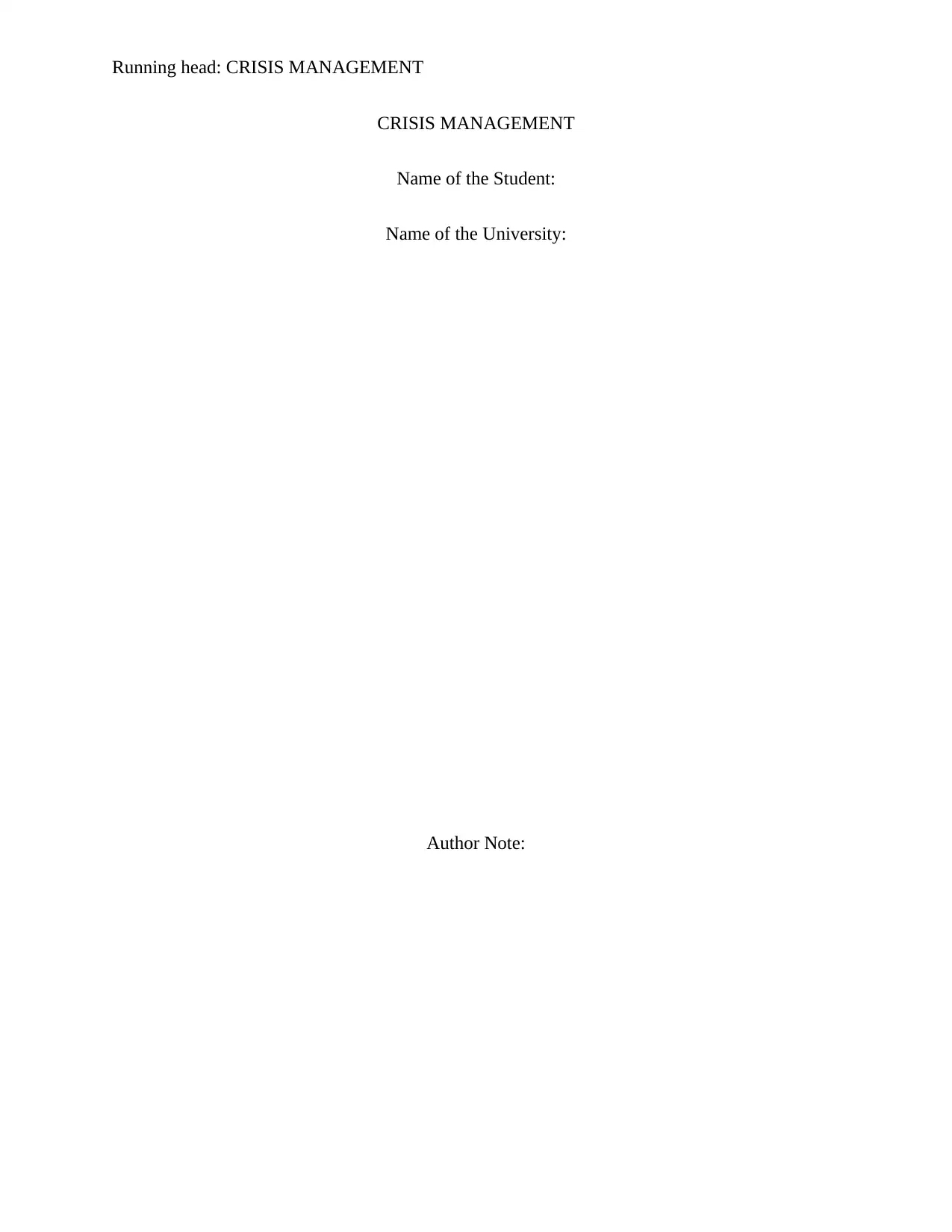
Running head: CRISIS MANAGEMENT
CRISIS MANAGEMENT
Name of the Student:
Name of the University:
Author Note:
CRISIS MANAGEMENT
Name of the Student:
Name of the University:
Author Note:
Paraphrase This Document
Need a fresh take? Get an instant paraphrase of this document with our AI Paraphraser
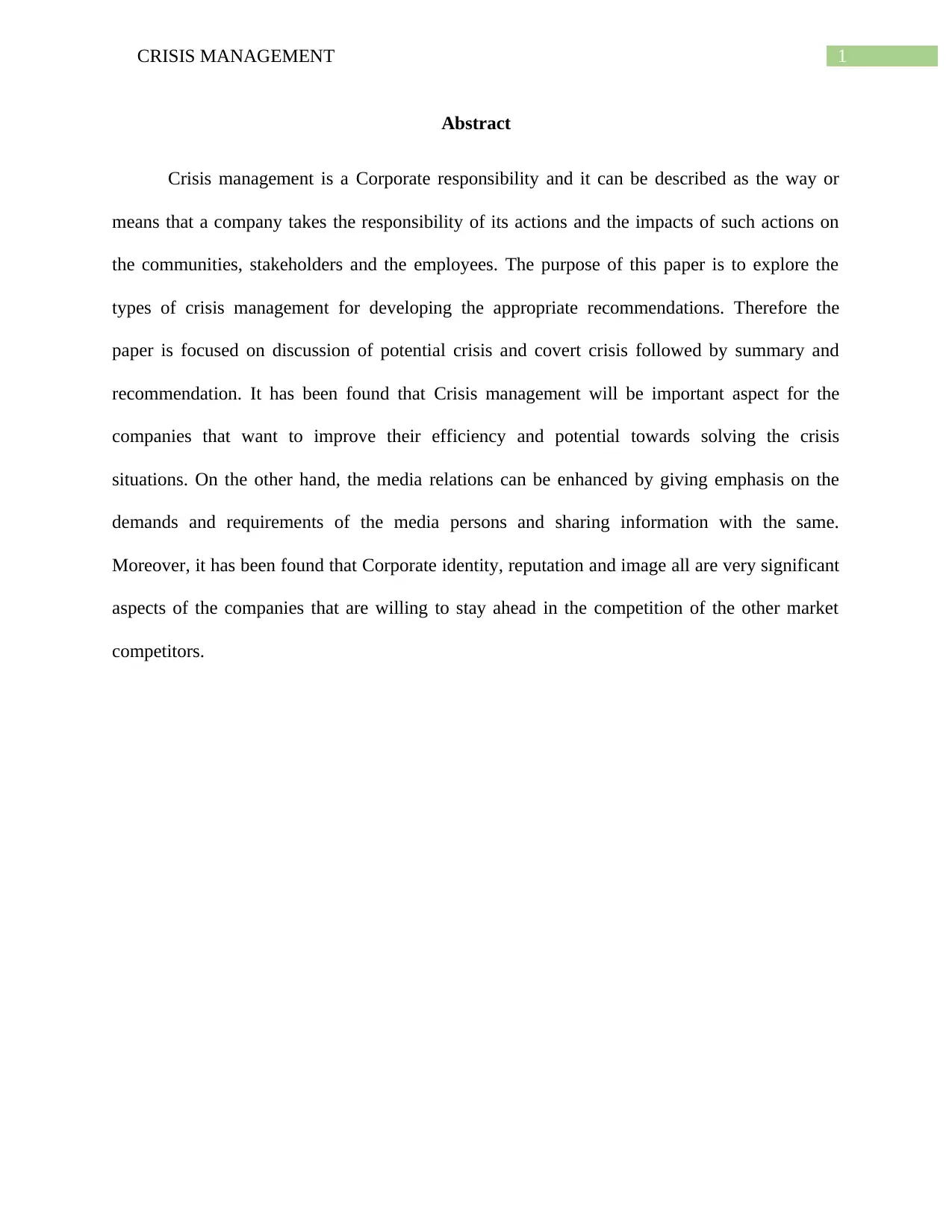
1CRISIS MANAGEMENT
Abstract
Crisis management is a Corporate responsibility and it can be described as the way or
means that a company takes the responsibility of its actions and the impacts of such actions on
the communities, stakeholders and the employees. The purpose of this paper is to explore the
types of crisis management for developing the appropriate recommendations. Therefore the
paper is focused on discussion of potential crisis and covert crisis followed by summary and
recommendation. It has been found that Crisis management will be important aspect for the
companies that want to improve their efficiency and potential towards solving the crisis
situations. On the other hand, the media relations can be enhanced by giving emphasis on the
demands and requirements of the media persons and sharing information with the same.
Moreover, it has been found that Corporate identity, reputation and image all are very significant
aspects of the companies that are willing to stay ahead in the competition of the other market
competitors.
Abstract
Crisis management is a Corporate responsibility and it can be described as the way or
means that a company takes the responsibility of its actions and the impacts of such actions on
the communities, stakeholders and the employees. The purpose of this paper is to explore the
types of crisis management for developing the appropriate recommendations. Therefore the
paper is focused on discussion of potential crisis and covert crisis followed by summary and
recommendation. It has been found that Crisis management will be important aspect for the
companies that want to improve their efficiency and potential towards solving the crisis
situations. On the other hand, the media relations can be enhanced by giving emphasis on the
demands and requirements of the media persons and sharing information with the same.
Moreover, it has been found that Corporate identity, reputation and image all are very significant
aspects of the companies that are willing to stay ahead in the competition of the other market
competitors.
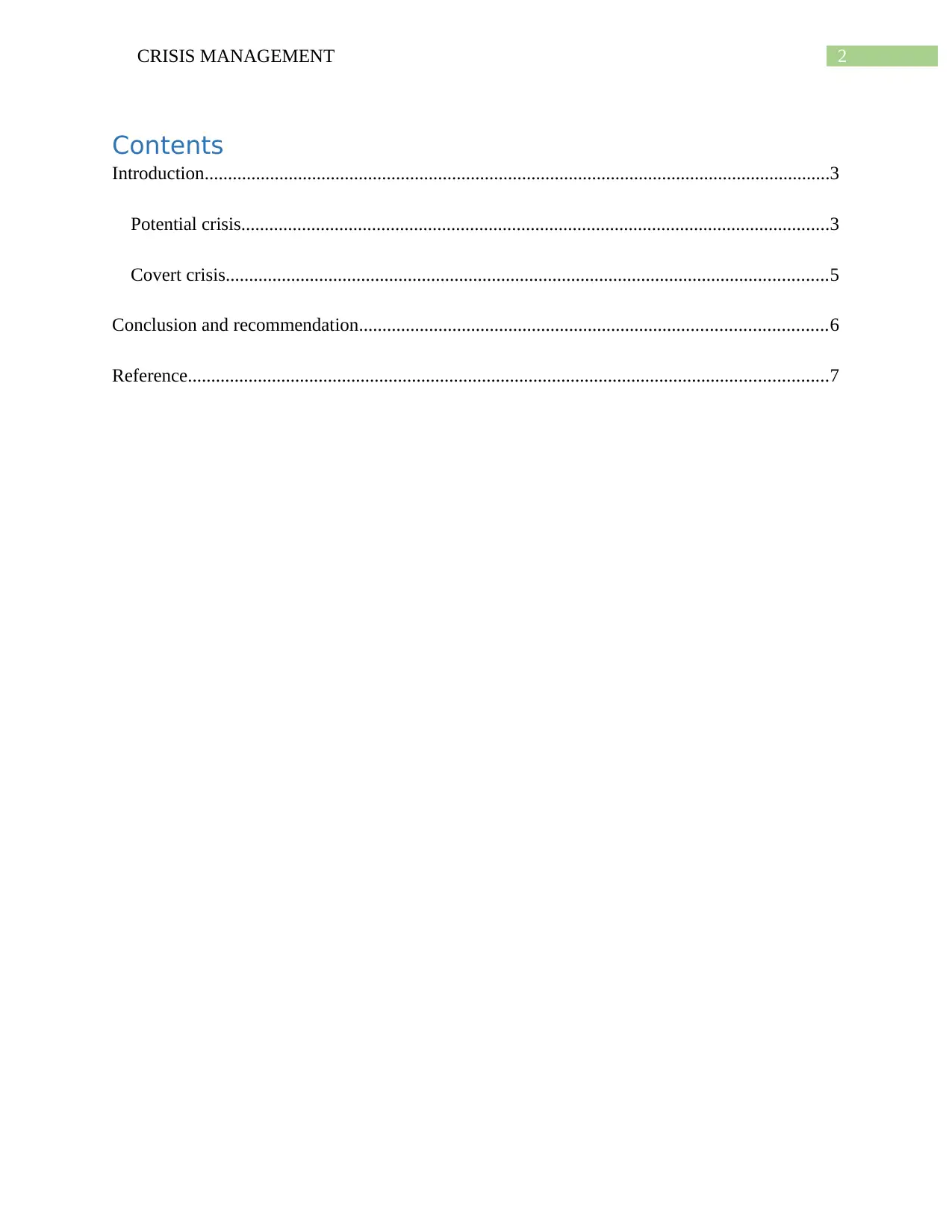
2CRISIS MANAGEMENT
Contents
Introduction......................................................................................................................................3
Potential crisis..............................................................................................................................3
Covert crisis.................................................................................................................................5
Conclusion and recommendation....................................................................................................6
Reference.........................................................................................................................................7
Contents
Introduction......................................................................................................................................3
Potential crisis..............................................................................................................................3
Covert crisis.................................................................................................................................5
Conclusion and recommendation....................................................................................................6
Reference.........................................................................................................................................7
⊘ This is a preview!⊘
Do you want full access?
Subscribe today to unlock all pages.

Trusted by 1+ million students worldwide
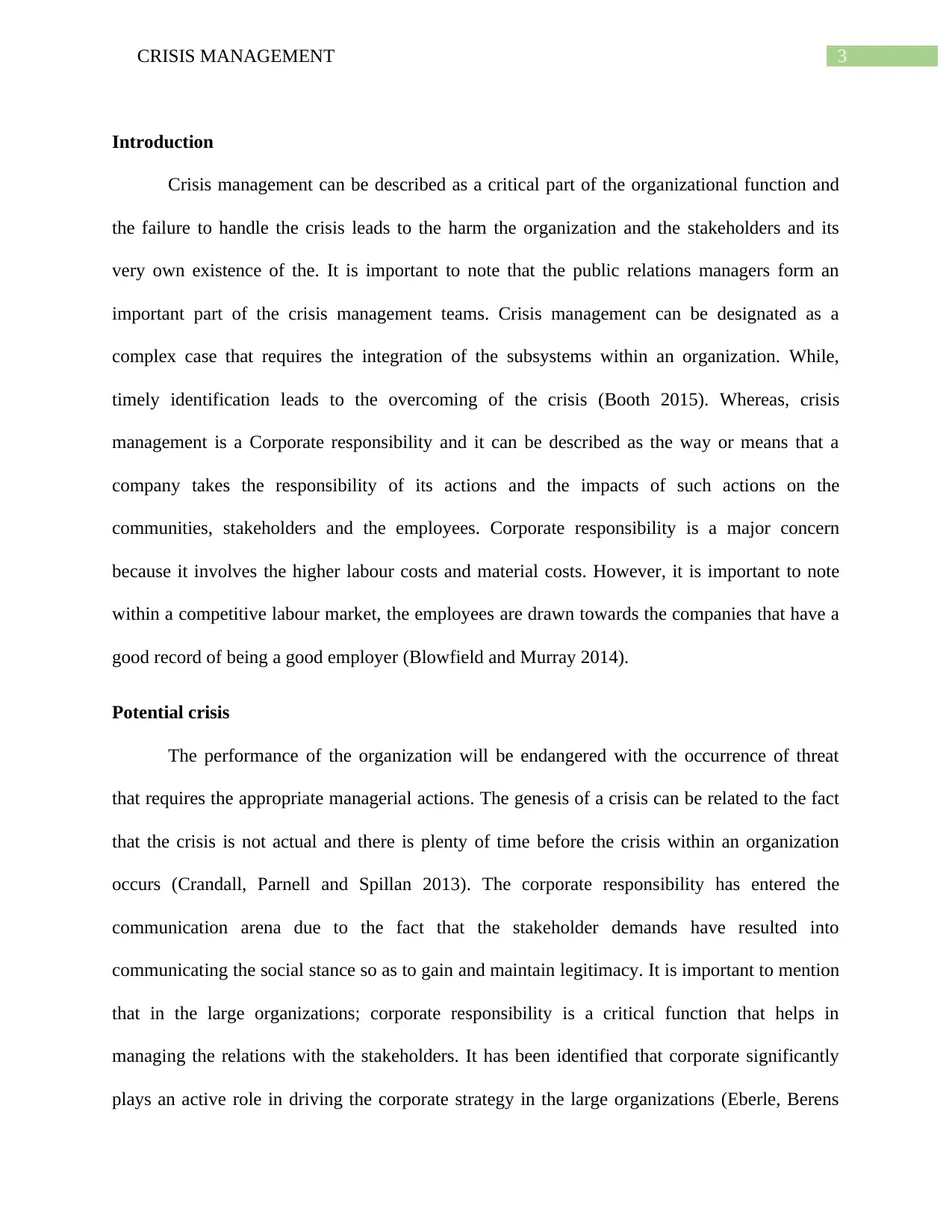
3CRISIS MANAGEMENT
Introduction
Crisis management can be described as a critical part of the organizational function and
the failure to handle the crisis leads to the harm the organization and the stakeholders and its
very own existence of the. It is important to note that the public relations managers form an
important part of the crisis management teams. Crisis management can be designated as a
complex case that requires the integration of the subsystems within an organization. While,
timely identification leads to the overcoming of the crisis (Booth 2015). Whereas, crisis
management is a Corporate responsibility and it can be described as the way or means that a
company takes the responsibility of its actions and the impacts of such actions on the
communities, stakeholders and the employees. Corporate responsibility is a major concern
because it involves the higher labour costs and material costs. However, it is important to note
within a competitive labour market, the employees are drawn towards the companies that have a
good record of being a good employer (Blowfield and Murray 2014).
Potential crisis
The performance of the organization will be endangered with the occurrence of threat
that requires the appropriate managerial actions. The genesis of a crisis can be related to the fact
that the crisis is not actual and there is plenty of time before the crisis within an organization
occurs (Crandall, Parnell and Spillan 2013). The corporate responsibility has entered the
communication arena due to the fact that the stakeholder demands have resulted into
communicating the social stance so as to gain and maintain legitimacy. It is important to mention
that in the large organizations; corporate responsibility is a critical function that helps in
managing the relations with the stakeholders. It has been identified that corporate significantly
plays an active role in driving the corporate strategy in the large organizations (Eberle, Berens
Introduction
Crisis management can be described as a critical part of the organizational function and
the failure to handle the crisis leads to the harm the organization and the stakeholders and its
very own existence of the. It is important to note that the public relations managers form an
important part of the crisis management teams. Crisis management can be designated as a
complex case that requires the integration of the subsystems within an organization. While,
timely identification leads to the overcoming of the crisis (Booth 2015). Whereas, crisis
management is a Corporate responsibility and it can be described as the way or means that a
company takes the responsibility of its actions and the impacts of such actions on the
communities, stakeholders and the employees. Corporate responsibility is a major concern
because it involves the higher labour costs and material costs. However, it is important to note
within a competitive labour market, the employees are drawn towards the companies that have a
good record of being a good employer (Blowfield and Murray 2014).
Potential crisis
The performance of the organization will be endangered with the occurrence of threat
that requires the appropriate managerial actions. The genesis of a crisis can be related to the fact
that the crisis is not actual and there is plenty of time before the crisis within an organization
occurs (Crandall, Parnell and Spillan 2013). The corporate responsibility has entered the
communication arena due to the fact that the stakeholder demands have resulted into
communicating the social stance so as to gain and maintain legitimacy. It is important to mention
that in the large organizations; corporate responsibility is a critical function that helps in
managing the relations with the stakeholders. It has been identified that corporate significantly
plays an active role in driving the corporate strategy in the large organizations (Eberle, Berens
Paraphrase This Document
Need a fresh take? Get an instant paraphrase of this document with our AI Paraphraser
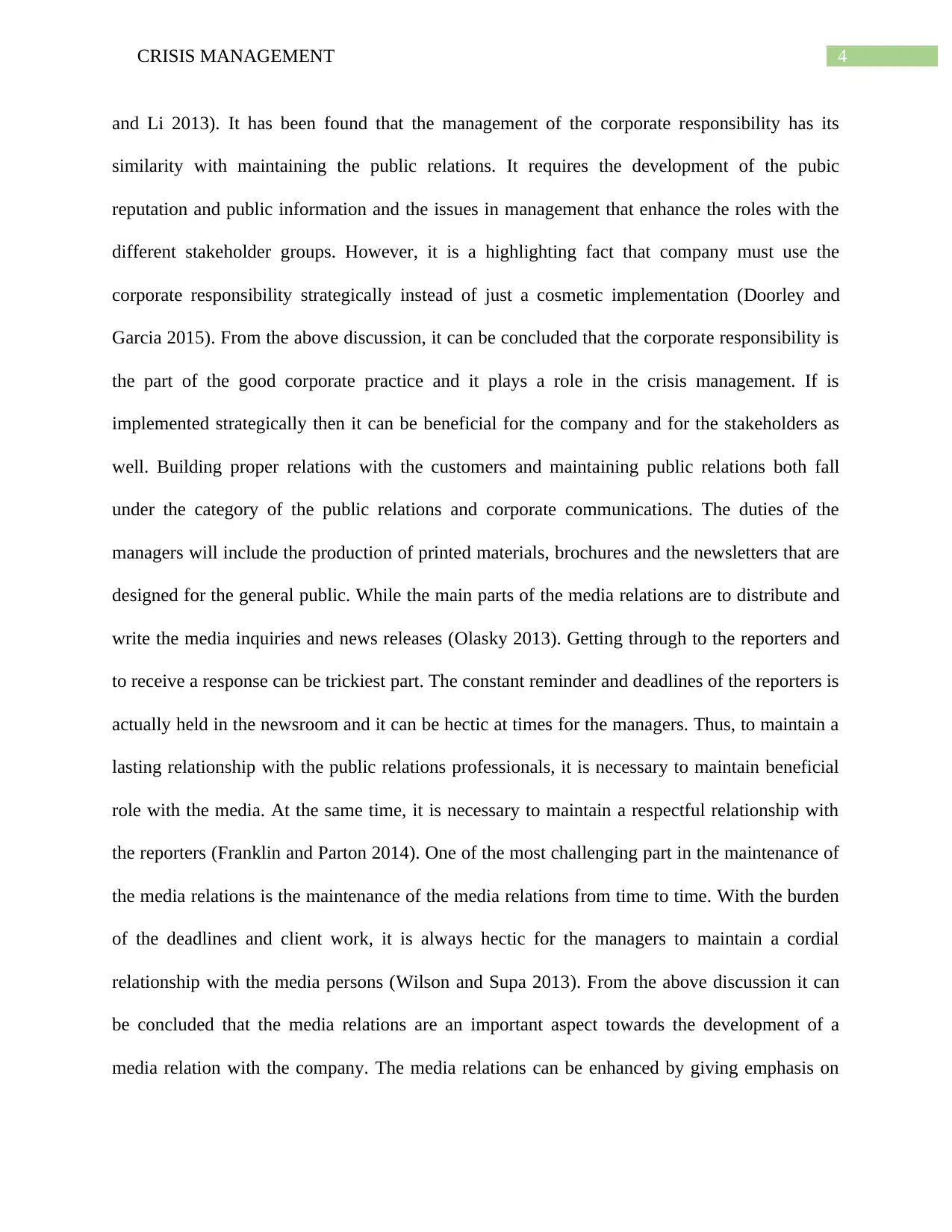
4CRISIS MANAGEMENT
and Li 2013). It has been found that the management of the corporate responsibility has its
similarity with maintaining the public relations. It requires the development of the pubic
reputation and public information and the issues in management that enhance the roles with the
different stakeholder groups. However, it is a highlighting fact that company must use the
corporate responsibility strategically instead of just a cosmetic implementation (Doorley and
Garcia 2015). From the above discussion, it can be concluded that the corporate responsibility is
the part of the good corporate practice and it plays a role in the crisis management. If is
implemented strategically then it can be beneficial for the company and for the stakeholders as
well. Building proper relations with the customers and maintaining public relations both fall
under the category of the public relations and corporate communications. The duties of the
managers will include the production of printed materials, brochures and the newsletters that are
designed for the general public. While the main parts of the media relations are to distribute and
write the media inquiries and news releases (Olasky 2013). Getting through to the reporters and
to receive a response can be trickiest part. The constant reminder and deadlines of the reporters is
actually held in the newsroom and it can be hectic at times for the managers. Thus, to maintain a
lasting relationship with the public relations professionals, it is necessary to maintain beneficial
role with the media. At the same time, it is necessary to maintain a respectful relationship with
the reporters (Franklin and Parton 2014). One of the most challenging part in the maintenance of
the media relations is the maintenance of the media relations from time to time. With the burden
of the deadlines and client work, it is always hectic for the managers to maintain a cordial
relationship with the media persons (Wilson and Supa 2013). From the above discussion it can
be concluded that the media relations are an important aspect towards the development of a
media relation with the company. The media relations can be enhanced by giving emphasis on
and Li 2013). It has been found that the management of the corporate responsibility has its
similarity with maintaining the public relations. It requires the development of the pubic
reputation and public information and the issues in management that enhance the roles with the
different stakeholder groups. However, it is a highlighting fact that company must use the
corporate responsibility strategically instead of just a cosmetic implementation (Doorley and
Garcia 2015). From the above discussion, it can be concluded that the corporate responsibility is
the part of the good corporate practice and it plays a role in the crisis management. If is
implemented strategically then it can be beneficial for the company and for the stakeholders as
well. Building proper relations with the customers and maintaining public relations both fall
under the category of the public relations and corporate communications. The duties of the
managers will include the production of printed materials, brochures and the newsletters that are
designed for the general public. While the main parts of the media relations are to distribute and
write the media inquiries and news releases (Olasky 2013). Getting through to the reporters and
to receive a response can be trickiest part. The constant reminder and deadlines of the reporters is
actually held in the newsroom and it can be hectic at times for the managers. Thus, to maintain a
lasting relationship with the public relations professionals, it is necessary to maintain beneficial
role with the media. At the same time, it is necessary to maintain a respectful relationship with
the reporters (Franklin and Parton 2014). One of the most challenging part in the maintenance of
the media relations is the maintenance of the media relations from time to time. With the burden
of the deadlines and client work, it is always hectic for the managers to maintain a cordial
relationship with the media persons (Wilson and Supa 2013). From the above discussion it can
be concluded that the media relations are an important aspect towards the development of a
media relation with the company. The media relations can be enhanced by giving emphasis on
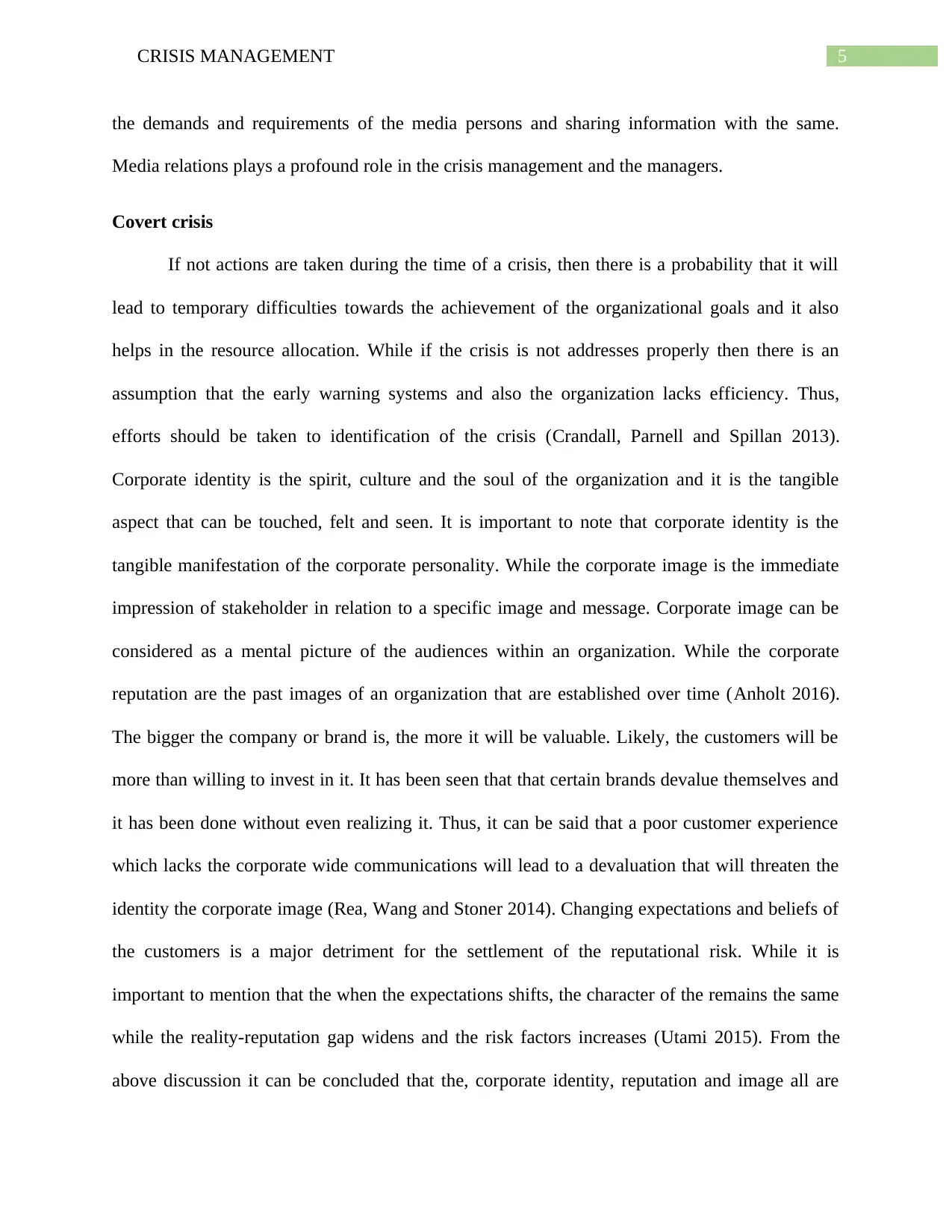
5CRISIS MANAGEMENT
the demands and requirements of the media persons and sharing information with the same.
Media relations plays a profound role in the crisis management and the managers.
Covert crisis
If not actions are taken during the time of a crisis, then there is a probability that it will
lead to temporary difficulties towards the achievement of the organizational goals and it also
helps in the resource allocation. While if the crisis is not addresses properly then there is an
assumption that the early warning systems and also the organization lacks efficiency. Thus,
efforts should be taken to identification of the crisis (Crandall, Parnell and Spillan 2013).
Corporate identity is the spirit, culture and the soul of the organization and it is the tangible
aspect that can be touched, felt and seen. It is important to note that corporate identity is the
tangible manifestation of the corporate personality. While the corporate image is the immediate
impression of stakeholder in relation to a specific image and message. Corporate image can be
considered as a mental picture of the audiences within an organization. While the corporate
reputation are the past images of an organization that are established over time (Anholt 2016).
The bigger the company or brand is, the more it will be valuable. Likely, the customers will be
more than willing to invest in it. It has been seen that that certain brands devalue themselves and
it has been done without even realizing it. Thus, it can be said that a poor customer experience
which lacks the corporate wide communications will lead to a devaluation that will threaten the
identity the corporate image (Rea, Wang and Stoner 2014). Changing expectations and beliefs of
the customers is a major detriment for the settlement of the reputational risk. While it is
important to mention that the when the expectations shifts, the character of the remains the same
while the reality-reputation gap widens and the risk factors increases (Utami 2015). From the
above discussion it can be concluded that the, corporate identity, reputation and image all are
the demands and requirements of the media persons and sharing information with the same.
Media relations plays a profound role in the crisis management and the managers.
Covert crisis
If not actions are taken during the time of a crisis, then there is a probability that it will
lead to temporary difficulties towards the achievement of the organizational goals and it also
helps in the resource allocation. While if the crisis is not addresses properly then there is an
assumption that the early warning systems and also the organization lacks efficiency. Thus,
efforts should be taken to identification of the crisis (Crandall, Parnell and Spillan 2013).
Corporate identity is the spirit, culture and the soul of the organization and it is the tangible
aspect that can be touched, felt and seen. It is important to note that corporate identity is the
tangible manifestation of the corporate personality. While the corporate image is the immediate
impression of stakeholder in relation to a specific image and message. Corporate image can be
considered as a mental picture of the audiences within an organization. While the corporate
reputation are the past images of an organization that are established over time (Anholt 2016).
The bigger the company or brand is, the more it will be valuable. Likely, the customers will be
more than willing to invest in it. It has been seen that that certain brands devalue themselves and
it has been done without even realizing it. Thus, it can be said that a poor customer experience
which lacks the corporate wide communications will lead to a devaluation that will threaten the
identity the corporate image (Rea, Wang and Stoner 2014). Changing expectations and beliefs of
the customers is a major detriment for the settlement of the reputational risk. While it is
important to mention that the when the expectations shifts, the character of the remains the same
while the reality-reputation gap widens and the risk factors increases (Utami 2015). From the
above discussion it can be concluded that the, corporate identity, reputation and image all are
⊘ This is a preview!⊘
Do you want full access?
Subscribe today to unlock all pages.

Trusted by 1+ million students worldwide
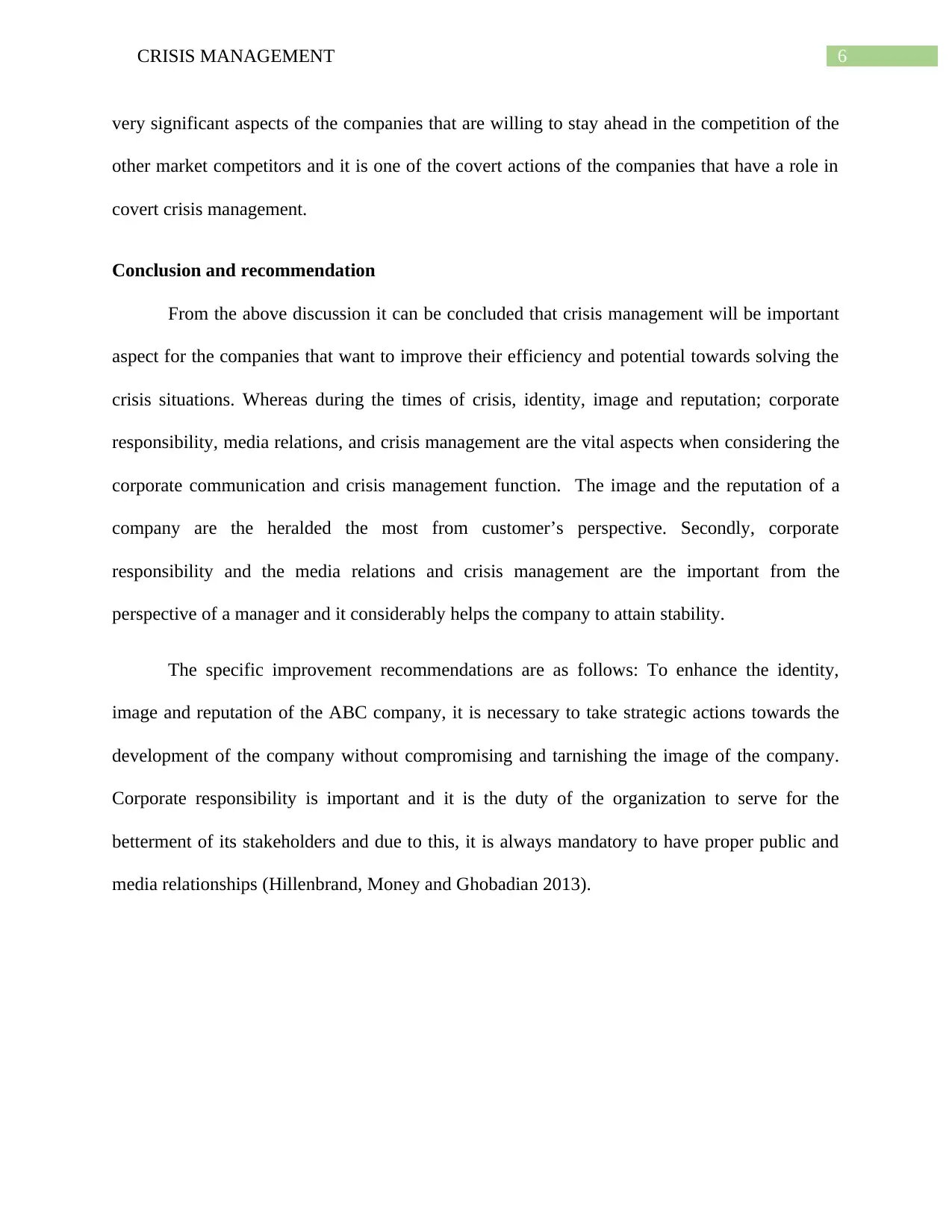
6CRISIS MANAGEMENT
very significant aspects of the companies that are willing to stay ahead in the competition of the
other market competitors and it is one of the covert actions of the companies that have a role in
covert crisis management.
Conclusion and recommendation
From the above discussion it can be concluded that crisis management will be important
aspect for the companies that want to improve their efficiency and potential towards solving the
crisis situations. Whereas during the times of crisis, identity, image and reputation; corporate
responsibility, media relations, and crisis management are the vital aspects when considering the
corporate communication and crisis management function. The image and the reputation of a
company are the heralded the most from customer’s perspective. Secondly, corporate
responsibility and the media relations and crisis management are the important from the
perspective of a manager and it considerably helps the company to attain stability.
The specific improvement recommendations are as follows: To enhance the identity,
image and reputation of the ABC company, it is necessary to take strategic actions towards the
development of the company without compromising and tarnishing the image of the company.
Corporate responsibility is important and it is the duty of the organization to serve for the
betterment of its stakeholders and due to this, it is always mandatory to have proper public and
media relationships (Hillenbrand, Money and Ghobadian 2013).
very significant aspects of the companies that are willing to stay ahead in the competition of the
other market competitors and it is one of the covert actions of the companies that have a role in
covert crisis management.
Conclusion and recommendation
From the above discussion it can be concluded that crisis management will be important
aspect for the companies that want to improve their efficiency and potential towards solving the
crisis situations. Whereas during the times of crisis, identity, image and reputation; corporate
responsibility, media relations, and crisis management are the vital aspects when considering the
corporate communication and crisis management function. The image and the reputation of a
company are the heralded the most from customer’s perspective. Secondly, corporate
responsibility and the media relations and crisis management are the important from the
perspective of a manager and it considerably helps the company to attain stability.
The specific improvement recommendations are as follows: To enhance the identity,
image and reputation of the ABC company, it is necessary to take strategic actions towards the
development of the company without compromising and tarnishing the image of the company.
Corporate responsibility is important and it is the duty of the organization to serve for the
betterment of its stakeholders and due to this, it is always mandatory to have proper public and
media relationships (Hillenbrand, Money and Ghobadian 2013).
Paraphrase This Document
Need a fresh take? Get an instant paraphrase of this document with our AI Paraphraser
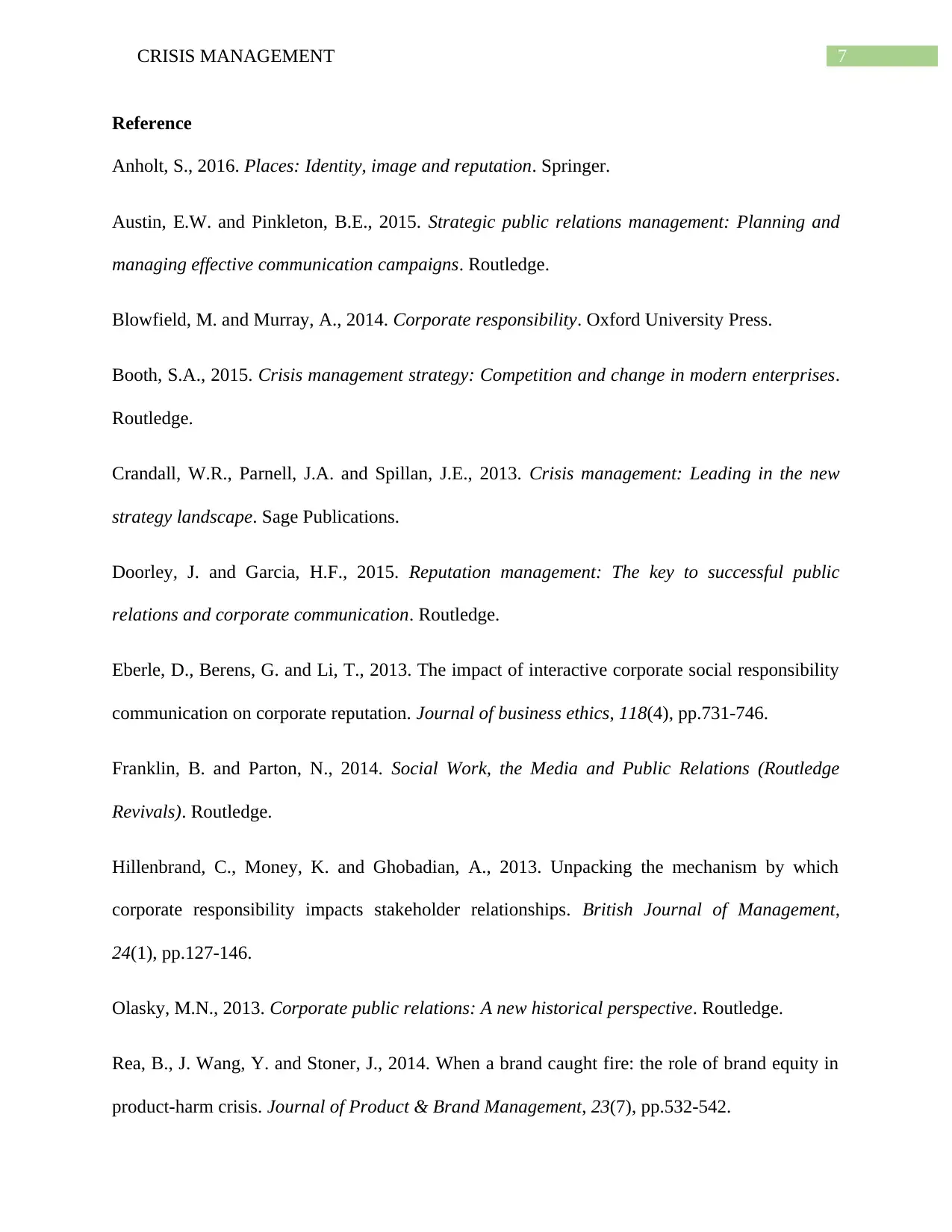
7CRISIS MANAGEMENT
Reference
Anholt, S., 2016. Places: Identity, image and reputation. Springer.
Austin, E.W. and Pinkleton, B.E., 2015. Strategic public relations management: Planning and
managing effective communication campaigns. Routledge.
Blowfield, M. and Murray, A., 2014. Corporate responsibility. Oxford University Press.
Booth, S.A., 2015. Crisis management strategy: Competition and change in modern enterprises.
Routledge.
Crandall, W.R., Parnell, J.A. and Spillan, J.E., 2013. Crisis management: Leading in the new
strategy landscape. Sage Publications.
Doorley, J. and Garcia, H.F., 2015. Reputation management: The key to successful public
relations and corporate communication. Routledge.
Eberle, D., Berens, G. and Li, T., 2013. The impact of interactive corporate social responsibility
communication on corporate reputation. Journal of business ethics, 118(4), pp.731-746.
Franklin, B. and Parton, N., 2014. Social Work, the Media and Public Relations (Routledge
Revivals). Routledge.
Hillenbrand, C., Money, K. and Ghobadian, A., 2013. Unpacking the mechanism by which
corporate responsibility impacts stakeholder relationships. British Journal of Management,
24(1), pp.127-146.
Olasky, M.N., 2013. Corporate public relations: A new historical perspective. Routledge.
Rea, B., J. Wang, Y. and Stoner, J., 2014. When a brand caught fire: the role of brand equity in
product-harm crisis. Journal of Product & Brand Management, 23(7), pp.532-542.
Reference
Anholt, S., 2016. Places: Identity, image and reputation. Springer.
Austin, E.W. and Pinkleton, B.E., 2015. Strategic public relations management: Planning and
managing effective communication campaigns. Routledge.
Blowfield, M. and Murray, A., 2014. Corporate responsibility. Oxford University Press.
Booth, S.A., 2015. Crisis management strategy: Competition and change in modern enterprises.
Routledge.
Crandall, W.R., Parnell, J.A. and Spillan, J.E., 2013. Crisis management: Leading in the new
strategy landscape. Sage Publications.
Doorley, J. and Garcia, H.F., 2015. Reputation management: The key to successful public
relations and corporate communication. Routledge.
Eberle, D., Berens, G. and Li, T., 2013. The impact of interactive corporate social responsibility
communication on corporate reputation. Journal of business ethics, 118(4), pp.731-746.
Franklin, B. and Parton, N., 2014. Social Work, the Media and Public Relations (Routledge
Revivals). Routledge.
Hillenbrand, C., Money, K. and Ghobadian, A., 2013. Unpacking the mechanism by which
corporate responsibility impacts stakeholder relationships. British Journal of Management,
24(1), pp.127-146.
Olasky, M.N., 2013. Corporate public relations: A new historical perspective. Routledge.
Rea, B., J. Wang, Y. and Stoner, J., 2014. When a brand caught fire: the role of brand equity in
product-harm crisis. Journal of Product & Brand Management, 23(7), pp.532-542.
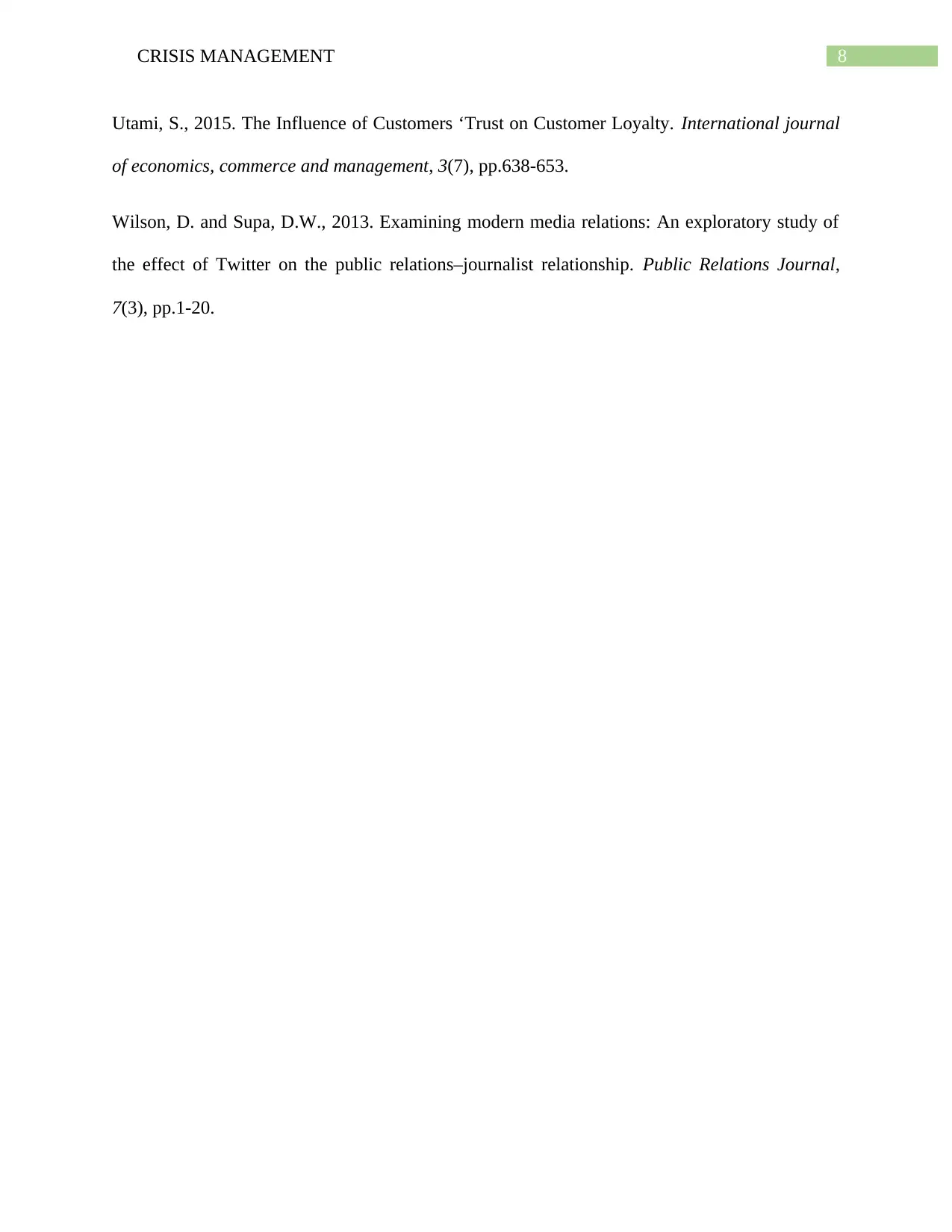
8CRISIS MANAGEMENT
Utami, S., 2015. The Influence of Customers ‘Trust on Customer Loyalty. International journal
of economics, commerce and management, 3(7), pp.638-653.
Wilson, D. and Supa, D.W., 2013. Examining modern media relations: An exploratory study of
the effect of Twitter on the public relations–journalist relationship. Public Relations Journal,
7(3), pp.1-20.
Utami, S., 2015. The Influence of Customers ‘Trust on Customer Loyalty. International journal
of economics, commerce and management, 3(7), pp.638-653.
Wilson, D. and Supa, D.W., 2013. Examining modern media relations: An exploratory study of
the effect of Twitter on the public relations–journalist relationship. Public Relations Journal,
7(3), pp.1-20.
⊘ This is a preview!⊘
Do you want full access?
Subscribe today to unlock all pages.

Trusted by 1+ million students worldwide
1 out of 9
Related Documents
Your All-in-One AI-Powered Toolkit for Academic Success.
+13062052269
info@desklib.com
Available 24*7 on WhatsApp / Email
![[object Object]](/_next/static/media/star-bottom.7253800d.svg)
Unlock your academic potential
Copyright © 2020–2025 A2Z Services. All Rights Reserved. Developed and managed by ZUCOL.





